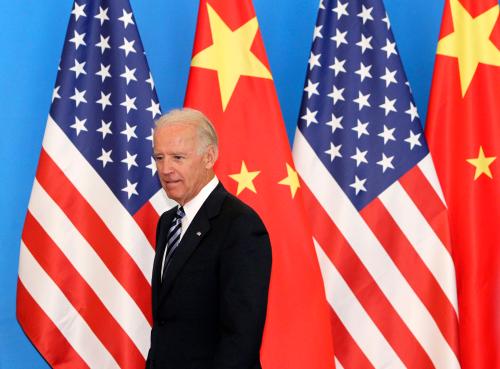As the leaders of the G-7 gathered for their summit in the U.K., the elephant was not in the room: China and its transition to a climate-smart growth. Over the last decade, China’s CO2 emissions rose by 25 percent to 14.1 billion tons and on a per capita basis increased to 10.1 billion tons a year, just below the OECD average.
While China’s emissions are very high, the country has also made notable progress in industrial restructuring, energy use efficiency, renewables in its energy mix, greenfield industries, and pilots for a carbon market. President Xi Jinping has said that China will achieve carbon emissions peak ahead of its 2030 target and would aim for net-zero emissions by 2060. More importantly, he also said that it is for China’s “own need to secure sustainable development.”
Since 2005, manufacturing and heavy industries have lowered their share of the GDP from 47 percent in 2005 to 41 percent in 2015, while services increased from 41 percent to 50 percent. This industrial transformation led to improvements in energy use efficiency. Coal consumption decreased to produce thermal power, cement, and steel (Figure 1).
Figure 1. Energy efficiency improvements in coal thermal plant, cement, and steel
Source: The People’s Republic of China Third National Communication on Climate Change (2019).
Energy consumption per unit of transport workload also decreased from 2005 to 2015. For instance, it dropped by 28 percent in railways as China built more energy efficient high-speed railways, 20 percent in waterways, 16 percent in highways, 14 percent for road transport, and 14 percent in aviation. Today, China is the world leader in electric vehicles. China is already ahead of most G-7 countries in transport energy efficiency.
China’s energy consumption mix has also been changing (Figure 2). Coal and oil are still significant but the share of nonfossil energy in primary energy consumption has increased in the last decade.
Figure 2. Growth of renewables in China’s energy mix
China has introduced a raft of market and nonmarket policy instruments—phasing out of inefficient and energy-intensive industries, energy targets in renewables and electric vehicles, tiered electricity pricing, abolition of consumption tax on low-emission vehicles, and introduction of preferential taxes on clean production and circular economy green bonds. China also mandated a reduction in energy-use targets in state-owned heavy industries, buildings, transportation, agriculture, commercial enterprises and households, and public institutions. Today, 100 percent of new buildings and towns in China are covered by energy conservation standards.
China has also been investing heavily in advanced semiconductors, robots, additive manufacturing, intelligent systems, new-generation aviation equipment, integrated service system for space technologies, intelligent transportation, precision medicine, efficient energy storage and distributed energy system, intelligent materials, circular economy, virtual reality, and interactive film and television. China also has plans to develop aerospace and marine technology, information network, life sciences and nuclear technology. In 2019, these new technologies accounted for about 19 percent of China’s GDP.
In 2011, China launched seven pilot projects on carbon emissions trading. By end of 2015, the pilots managed to cover 20 industries, at least 2,600 key emission discharging units, and an annual emission allowance of about 1,240 metric tons of CO2 eq. In 2017, China launched a national pilot on CO2 emissions trading, starting with the power generation sector. If successful, this will be a significant milestone in laying the foundations for emissions trading in China.
An important benefit of the carbon tax is the additional revenue generated. At a base price of $40 per metric ton of CO2 (per ton of CO2 emitted), at full operation, China could raise $285 billion in additional revenues from domestic carbon taxes or about 8.5 percent of its total revenues in 2018. This conservative amount could increase to $570 billion by 2050 when carbon prices rise to $80 per ton. This additional source of revenue is especially crucial for China’s heavily indebted local governments, which have very limited fiscal space. Domestic carbon taxes are easier and less controversial to impose compared to property taxes.
While China’s CO2 emissions have seen dramatic increases in recent years, the country has also made significant progress to achieve carbon peak by 2030 and hopefully reach its commitment of net-zero emissions much earlier than 2060. If there is one aspect of U.S.-China rivalry that the rest of the world would welcome, it is that the race to the top—the competition for climate smart growth—could help limit global warming to 1.5 degrees Celsius.









Commentary
What can the G-7 learn from China’s transition to climate-smart growth?
June 16, 2021